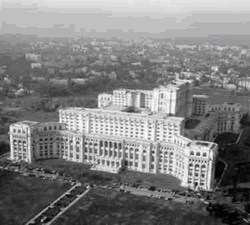Anti – Nato Week Bucharest 2008
The North Atlantic Treaty Organization (NATO) is a military alliance, established by the signing of the North Atlantic Treaty on 4 April 1949. With headquarters in Brussels, Belgium, the organization established a system of collective defense whereby its member states agree to mutual defense in response to an attack by any external party.
“ The Parties of NATO agreed that an armed attack against one or more of them in Europe or North America shall be considered an attack against them all. Consequently they agree that, if such an armed attack occurs, each of them, in exercise of the right of individual or collective self-defence will assist the Party or Parties being attacked,individually and in concert with the other Parties, such action as it deems necessary, including the use of armed force, to restore and maintain the security of the North Atlantic area. ”

The initial treaty was signed by Belgium, Netherlands,Luxembourg, France, United Kingdom, the United States of America, Italy, Norway, Denmark and Iceland which were followed after 3 years by Greece and Turkey. In 1954 Russia wanted to join NATO but was rejected by the NATO countries. In 1955 West Germany was incorporated into NATO, shortly after the Warsaw Pact was signed. The end of the Cold War and the dissolution of the Warsaw Pact in 1991 removed the de facto main adversary of NATO. At the moment NATO includes the next countries: Belgium, Canada, Denmark, France, Iceland, Italy, Luxembourg, Netherlands, Norway, Portugal, United Kingdom, USA, Greece, Turkey, Germany, Spain, Czech Republic, Hungary, Poland, Bulgaria, Estonia, Latvia, Lithuania, Romania, Slovakia, Slovenia. With the re-evaluation of NATO’s purpose in post-Cold War we could see a still ongoing expansion of NATO to Eastern Europe, as well as the extension of its activities to areas that had not formerly been NATO concerns. On 28 February 1994, NATO took its first military action, shooting down four Bosnian Serb aircraft violating a U.N.-mandated no-fly zone over central Bosnia and Herzegovina. At the end of 1995 the war in Bosnia resulted in the Dayton Agreement, with the help of air strikes by NATO. On 24 March 1999, NATO saw its first broad-scale military engagement in the Kosovo War, where it waged an 11-week bombing campaign against what was then the Federal Republic of Yugoslavia. A formal declaration of war never took place. The conflict ended on 11 June 1999, when Slobodan Milošević agreed to NATO’s demands. NATO then helped establish the KFOR, a NATO-led force under a United Nations mandate that operated the military mission in Kosovo.
After September 11th NATO confirmed on the 4th of October 2001 that the attacks where an attack against the entire group of members. On 16th of April 2003 NATO agreed to take command of the International Security Assistance Force (ISAF) in Afghanistan, which was the first time in NATO’s history to take charge of a mission outside of the north Atlantic area. But most people do not realize that there are approximately 49,000 foreign troops in Afghanistan, about one-third the number in Iraq. Of those troops, 28,000 are from the United States: 15,000 operate under NATO and 13,000 are part of the Pentagon’s Operation Enduring Freedom (OEF). The U.S.-NATO dichotomy is misleading, however, because the largest contingent of NATO troops is from the United States (the second-largest contingent from the UK is much smaller, only 7,700 soldiers). In addition, the military head of NATO operations, U.S. General Dan K. McNeill, is also the chief of OEF. In other words, America dominates all foreign troop operations in Afghanistan.
In fact, U.S. and NATO troops are doing the same things in Afghanistan and Iraq: bombing civilian areas, invading villages, rounding up people without evidence, torturing detainees, causing deaths in custody, and shooting into crowds. At the 9th of May 2007 the NATO secretary general met with the North Atlantic Council in Brussels and had discussions on the subject of civilian deaths. But the conversation was less about how to reduce casualties, than about how to explain them to European governments. To most officials, the criminality and injustice of the civilian deaths alone are not enough to condemn them. But when they undermine the support base at home or in the host country, and threaten the crucial “winning hearts and minds” portion of NATO’s counterinsurgency campaign, they become a strategic problem.
The facts are also clear, that there were secret prisons, certainly in Poland and Romania; and that people who suspected by the CIA of involvement in terrorism were interrogated and sometimes tortured in these prisons. NATO was also involved in the system of secret prisons and transports. After the US had, in 2001, issued a call for mutual support under Article 5 of the NATO treaty, NATO became a platform where the United States received the go-ahead and protective measures necessary in order to be able to begin the secret operations in the "war against terrorism". But of course NATO refuses to reveal details of the agreements concerning its involvement in the CIA Operation. But well who can be surprised if remembering that NATO also had a long held covert policy of training paramilitary militia as ‘Gladio’, known as ‘stay-behind’ armies, for a possible Soviet invasion of Western Europe, whose role would have been to wage guerrilla warfare behind enemy lines.
After September 11th Romania has expressed their willingness to join the USA in the war on terror and offered to help by sending military forces into Afghanistan and Iraq. In 2002 Romania was invited to the summit in Prague and began the accession process. In March 2004 Romania became a NATO member, as a ‘gratitude for it’s loyalty’. Romania now has military troops in Bosnia-Herzegovina, Kosovo, Afghanistan and Iraq. There are 4 US military bases in Romania, hosting more than 2.000 American soldiers.




